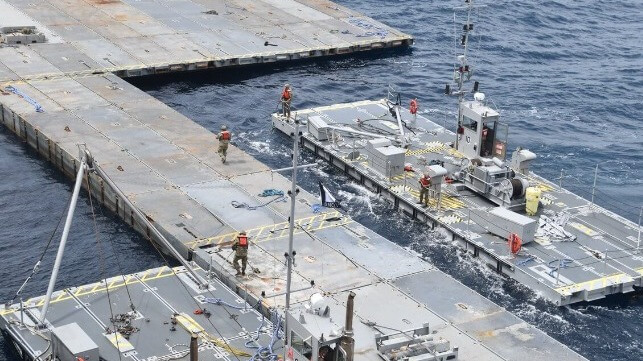Price Estimate for Gaza Maritime Aid Corridor: $320 Million

The U.S. military's new aid pier for Gaza is expected to cost $320 million or more, the Pentagon told media on Monday. The price has roughly doubled since planning began earlier this year.
The number is an estimate based on the cost of moving all related equipment for Joint Logistics Over the Shore (JLOTS) operations, assembling a temporary floating pier and an offshore receiving barge, carrying out shoreside construction (through third parties), and the actual movement of the aid supplies. The U.S. military regularly mobilizes JLOTS assets overseas for setup and takedown exercises, incurring some of the same costs without physical delivery of goods or aid supplies.
Based on satellite photos obtained by the AP, the civilian-crewed sealift ship USNS Roy P. Benavidez is already on scene off Gaza to begin setting up the pier, accompanied by several U.S. Army landing ships. (The Army plays a major role in JLOTS operations.)
An Israeli army engineering unit is handling the construction work to attach the pier's shoreside end to the beach in Gaza, officials have told AP. Once all is ready, aid will be loaded onto cargo trucks in Cyprus; driven aboard a sealift-capable ro/ro; shipped to the offshore JLOTS site off Gaza; driven off the ro/ro's ramp onto a floating receiving barge; driven off the receiving barge onto a self-propelled transfer barge; ferried to the pier; and driven off the transfer barge onto the floating pier.
This is where American involvement in the logistics chain ends. According to the BBC, British troops may provide the manpower to drive the trucks the "final mile" down the pier and over to a shoreside distribution point. The White House has pledged that there will be no American boots on the ground at any point in this complex operation, in part because of the threat posed by the terrorist organization Hamas. The Palestinian militant group is a sworn enemy of the United States, and has already threatened to attack the Israeli forces stationed at the port's perimeter.
The American-led effort is the largest maritime aid corridor for Gaza, but not the only one. The nonprofit World Central Kitchen has announced that it is restarting aid deliveries from Cyprus to Gaza, ending a month-long hiatus. The group paused its operations and recalled its vessel assets after a series of Israeli airstrikes killed seven of its personnel, including a U.S.-Canadian dual national. The group also conducts aid deliveries by truck, and says that it has more than 275 truckloads of food - enough for eight million meals - stalled on the Egyptian side of the Gaza border crossing. At peak flow, the maritime aid corridor will handle up to 150 trucks a day, according to the Pentagon.
Aid groups say that Israeli forces have loosened border restrictions under pressure from the White House, but the flow is still less than half of what it was before the start of the conflict. The UN has warned of the potential for widespread famine, particularly in northern Gaza, if food shipments are not restored.
